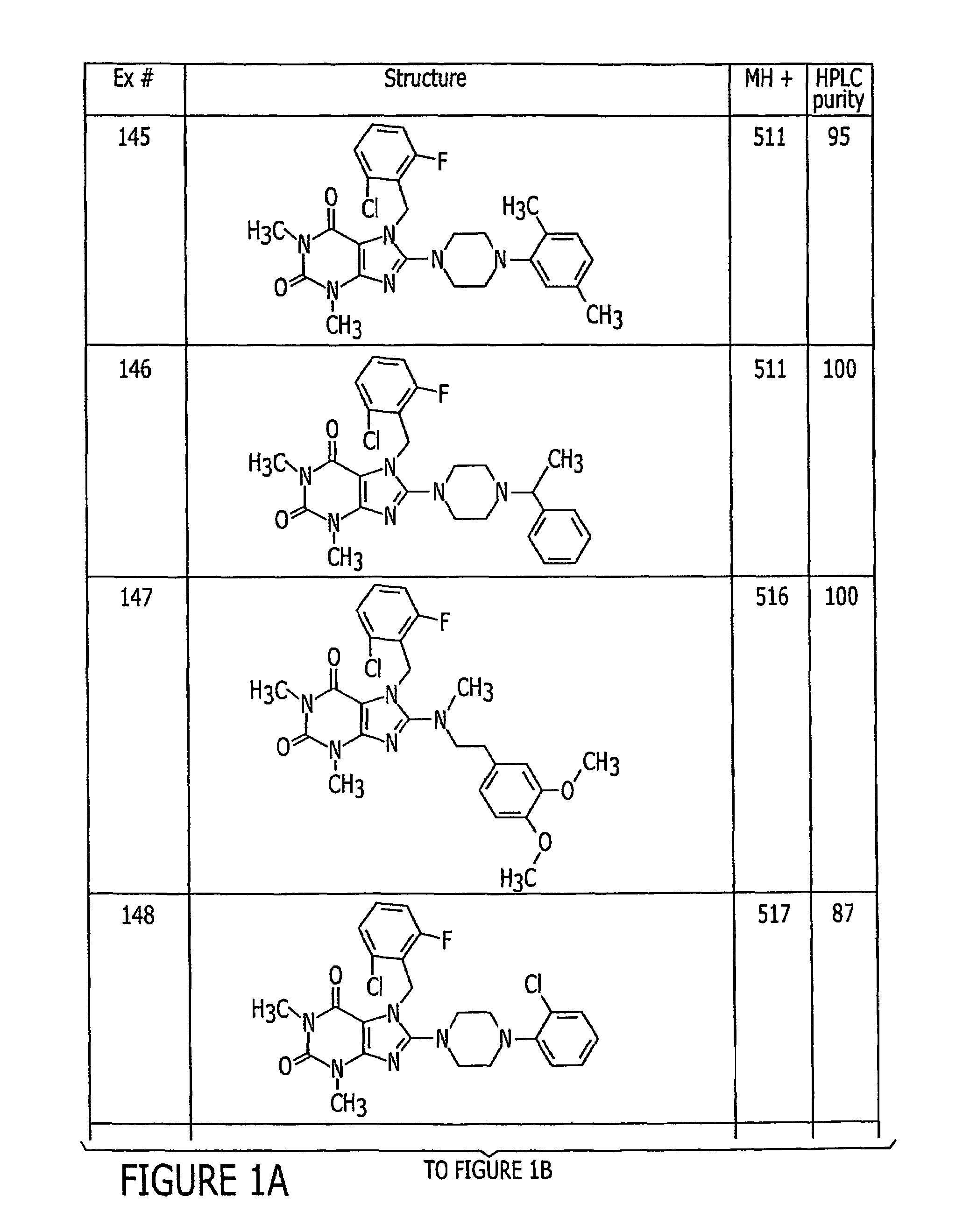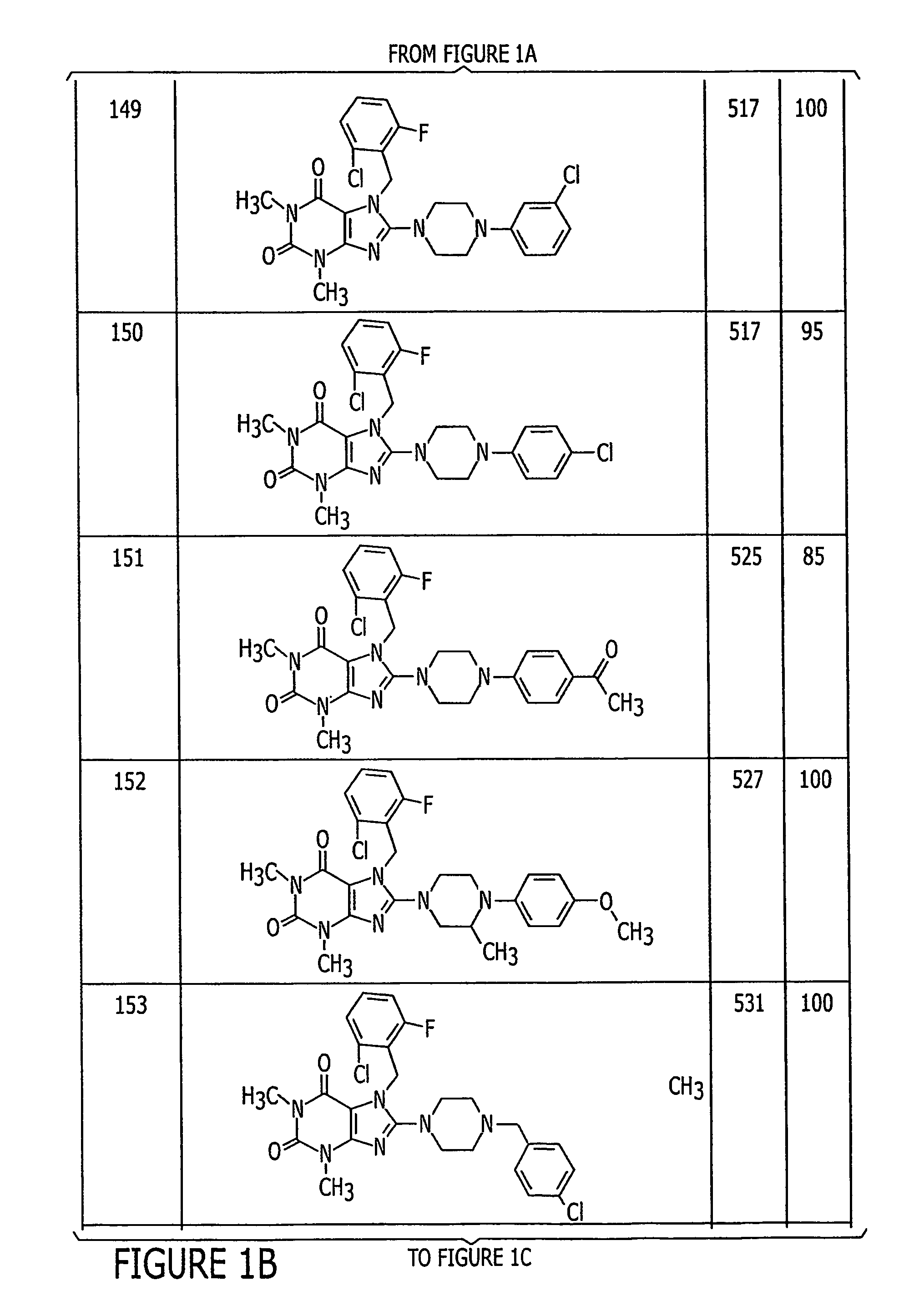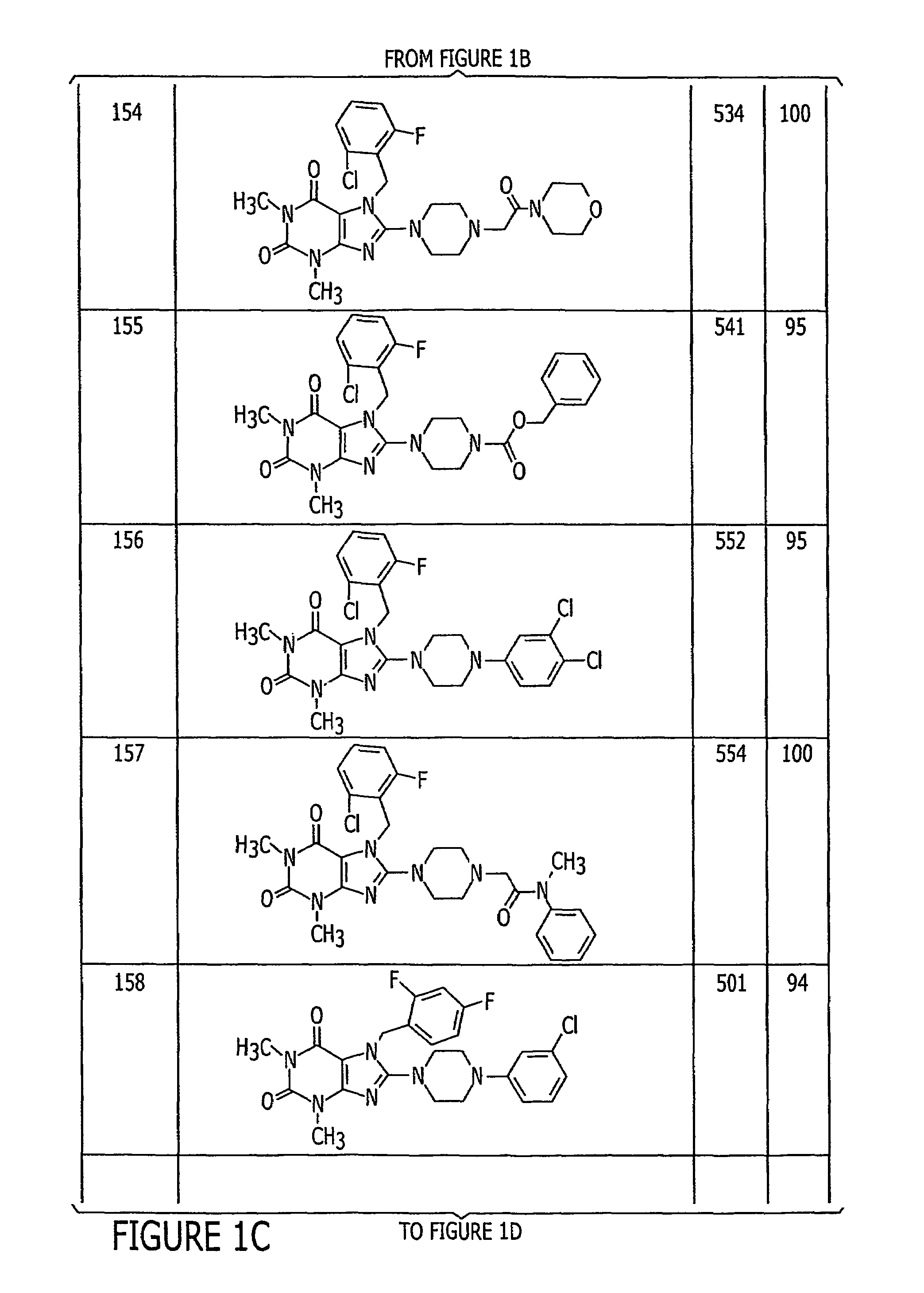Purine derivatives as liver X receptor agonists
a liver x receptor and purine derivative technology, applied in the field of liver x receptors, can solve the problems of high risk of cardiovascular disease, incomplete absence or low level of hdl cholesterol, etc., and achieve the effect of preventing or treating an lxr-mediated diseas
- Summary
- Abstract
- Description
- Claims
- Application Information
AI Technical Summary
Problems solved by technology
Method used
Image
Examples
example 1
N-(2-chloro-6-fluorobenzyl)-N′-cyanopiperidine-1-carboximidamide
[0429]
[0430]A solution of diphenylcyanocarboimidate (10 g, 42 mmol) in 168 mL CH2Cl2 was treated with 2-chloro-6-fluorobenzylamine (6.7 g, 42 mmol) and diisopropylethylamine (7.3 mL, 42 mmol). The reaction mixture was stirred at room temperature for 24 hr. The solvent was removed by reduced pressure and the remaining white solid was diluted with CH2Cl2 and H2O and extracted 3× with CH2Cl2. The organic layers were combined and the solvent removed by reduced pressure yielding a crude white solid. This intermediate (12.8 g, 42 mmol) was dissolved in 80 mL acetonitrile and treated with piperidine (6.2 mL, 63 mmol). The reaction was heated to reflux for 24 hr. The reaction mixture was cooled and the solvent removed by reduced pressure. The crude product was triturated with ether and collected by filtration to yield a white solid (10 g, 82% yield): 1H NMR (CDCl3, 400 MHz) 7.28-7.23 (m, 1H), 7.22-7.18 (m, 1H), 7.04-6.98 (m, 1H...
example 2
Methyl 4-amino-1-(2-chloro-6-fluorobenzyl)-2-piperidin-1-yl-1H-imidazole-5-carboxylate
[0431]
[0432]A solution of N-(2-chloro-6-fluorobenzyl)-N′-cyanopiperidine-1-carboximidamide (8.35 g, 28.3 mmol) in 142 mL DMF was cooled to 0° C. and treated in portions with NaH (1.25 g, 31.2 mmol). The reaction mixture was stirred for 30 min at 0° C. and then methylbromoacetate (2.95 mL, 31.2 mmol) was added dropwise. The reaction was slowly brought to room temperature and stirred for 15 hr. The reaction was quenched with 20 mL saturated aqueous NH4Cl and extracted with 50% EtOAc:hexanes. The organic layers were combined and the solvent was removed by reduced pressure. The crude product was filtered through a large silica plug and rinsed with 50% EtOAc:hexanes to yield 8.83 g (85% yield) of a yellow oil. This oil (8.83 g, 24.1 mmol) was dissolved in 241 mL THF, treated with 0.5 M NaOMe in MeOH (4.8 mL, 2.41 mmol), and stirred for 4 hr. The reaction mixture was filtered through a large silica plug ...
example 3
7-(2-chloro-6-fluorobenzyl)-3-methyl-1-phenyl-8-piperidin-1-yl-3,7-dihydro-1H-purine-2,6-dione
[0433]
[0434]In a sealed tube, a solution of methyl 4-amino-1-(2-chloro-6-fluorobenzyl)-2-piperidin-1-yl-1H-imidazole-5-carboxylate (150 mg, 0.41 mmol) in xylenes (3.5 mL) was treated with phenyl isocyanate (98 □L, 0.90 mmol). The reaction was heated to 140° C. for 3 hr. cooled to room temperature, and concentrated in vacuo. The crude product was purified by flash chromatography (silica gel cartridge, Biotage, 32-63 □m, 60 Å) with 33% EtOAc:hexanes as the eluent to afford 160 mg (80% yield) of the urea intermediate. The urea (150 mg, 0.31 mmol) was dissolved in MeOH (3.1 mL) and treated with 0.5 M NaOMe in MeOH (1.36 mL, 0.68 mmol). The reaction was heated to 80° C. and stirred for 1 hr. The crude product was filtered through a plug of silica and rinsed with 100% EtOAc to yield the cyclized intermediate (83 mg, 59% yield). A solution of this intermediate (20 mg, 0.044 mmol) and K2CO3 (61 mg,...
PUM
| Property | Measurement | Unit |
|---|---|---|
| particle size | aaaaa | aaaaa |
| temperature | aaaaa | aaaaa |
| temperature | aaaaa | aaaaa |
Abstract
Description
Claims
Application Information
 Login to View More
Login to View More - R&D
- Intellectual Property
- Life Sciences
- Materials
- Tech Scout
- Unparalleled Data Quality
- Higher Quality Content
- 60% Fewer Hallucinations
Browse by: Latest US Patents, China's latest patents, Technical Efficacy Thesaurus, Application Domain, Technology Topic, Popular Technical Reports.
© 2025 PatSnap. All rights reserved.Legal|Privacy policy|Modern Slavery Act Transparency Statement|Sitemap|About US| Contact US: help@patsnap.com



